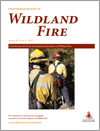International Journal of Wildland Fire
Volume 28
Number 2 2019
Wildfire fatalities remain a significant problem in Mediterranean Europe. There is a strong inter-annual variability in losses. Repeated tragic accidents remind us of this grim reality, regardless of the increasing firefighting capacity aiming to improve human safety. This paper presents an analysis of 865 fatalities over the period 1945–2016.
This paper presents a web-based wildfire simulator designed for the real-time support of wildfire management operations. The simulator is a client–server application parallelised to minimise computational run-time. The paper shows the simulator capabilities on a set of actual wildfires. The simulator is also suitable for training personnel.
In WUI, a fire is often initiated in litter, then can propagate to the plant canopy when its lower part is close to the ground. Comparing experimental and numerical results showed that, mostly, modelling the fire propagation at the scale of a branch was possible using WFDS but only if the branch moisture content remained lower than 25%. Improvements are needed to use higher moisture contents in the modelling.
Live fuel moisture content is a factor in the rate of spread of fire that might have been underestimated from shrubland field experiments. In this paper, we show why, and also evaluate the actual magnitude of its impact, which was found to be large for typical values occurring during fire seasons.
We compared records of individual fires between two 14-year periods (1911–24 and 2002–05) to better understand change in fire occurrence, and the possible factors driving change. Surprisingly, the annual number of human-caused fires did not change between periods. However, there was major shift towards much larger fires in the contemporary period.
We derived flammability functions from landscapes with alternative stable-states (shrublands and forest). Shrublands dominated the time since fire–flammability relationship even when they were less abundant in the landscape. These non-additive effects could have an important role in accelerating landscapes transformations towards more flammable states.
The seeds of the native species of the UNESCO Biosphere Reserve Torres del Paine National Park are more sensitive to heat than those of alien plant species. Therefore, fires threaten the native species of this reserve directly by killing seeds and indirectly by promoting fire-tolerant exotics, which are highly competitive in post-fire environments.
This study evaluates a gas-sensor system for early eucalypt-forest fire detection. A gas-sensor array was calibrated to volatile organic compounds emitted by heated Tasmanian bluegum (Eucalyptus globulus) biomass. The sensor can monitor emissions from burning E. globulus leaf and wood tissue, and pre-ignition stages can be detected.
 , Gavriil Xanthopoulos, Michalis Diakakis, Luis Ribeiro, David Caballero, Giuseppe M. Delogu, Domingos X. Viegas, Carlos A. Silva and Adrián Cardil
, Gavriil Xanthopoulos, Michalis Diakakis, Luis Ribeiro, David Caballero, Giuseppe M. Delogu, Domingos X. Viegas, Carlos A. Silva and Adrián Cardil




